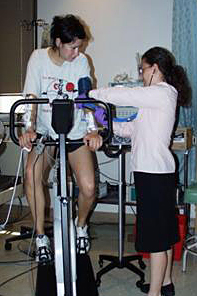Human Research Protocols

Many of the research protocols investigate physiological mechanisms of glucose counter-regulation in response to glucose clamps. With glucose clamps, blood glucose is maintained for periods of time at specific desired levels. Examples of clamped glucose levels are euglycemia (normal blood glucose, ~90 mg/dl) or various levels of hypoglycemia (low blood glucose, one standard hypoglycemic clamp we use is ~50mg/dl), or hyperglycemia (looking at levels of glycemia over 180 mg/dl). A physiologic level of insulin is continuously infused and a dextrose infusion is variably infused to maintain blood glucose at desired levels.
Exercise, investigational devices, medications, cardiovascular effects, and investigational drugs are also studied in conjunction with glucose clamps. This not only helps to determine their physiologic effects, but may lead to more effective ways of treating diabetes. Human Research at University of Maryland, Baltimore, is under the auspices of the Human Research Protections Office located at Biopark I, 800 W. Baltimore St., Suite 100, Baltimore, MD 21201.
Active Protocols in the Davis Lab:
- Mechanisms of Hypoglycemia Associated Autonomic Dysfunction, GLP-1 and Hypoglycemia (recruiting Type 2 DM participants)
- Mechanisms of Hypoglycemia Associated Autonomic Dysfunction, Differing Levels of Hypoglycemia (recruiting Healthy participants)
- Mechanisms of Hypoglycemia Associated Autonomic Dysfunction, Dose Response of Epinephrine (recruiting Healthy participants)
